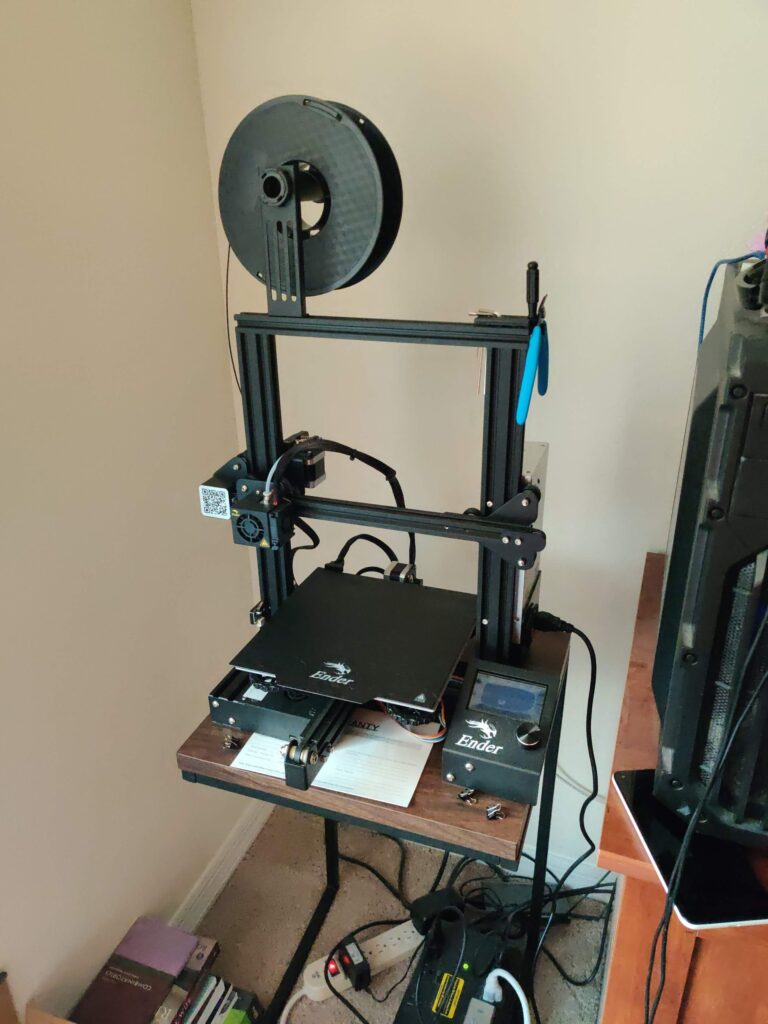I love 3D printing! However, the love doesn’t come from the result. It comes from the journey, the tinkering, the wrenching and experimenting to find out what works. This article is about what doesn’t work. These were my (sometimes expensive) lessons learned, memorialized here for my better self-education, my bad memory, and just maybe for the benefit of somebody else.

Knowledge Before 💸💸💸
Learn, times three! If you don’t like to learn, pick a different hobby. 3D printing is not yet consumer friendly enough for general use unless you have a passion for the printing itself in my humble opinion. The first mistake I made was right at the outset by buying a 3D printer before properly educating myself on topics such as what kinds of printers exist, how a printer is maintained, and how does the choice of printer help achieve my goals. Filiments? Materials? Nah, I bought what was popular and sufficiently cheap.
I bought an Ender 3 clone off Amazon. It’s good that this was a popular model because I had no shortage of learning materials post-purchase. However, had I known about the amazing quality of life improvements available like a good touch interface, maybe a web interface option, or at minimum an automated bed level tool (you do kind of need this!), I could have avoided buying those expensive upgrades piecemeal and the struggle of manual integration with the rest of the platform. At least this is cheaper than my ham radio hobby. I didn’t truly start having fun until I upgraded my printer to reduce maintenance and provide the user experience I craved.
Direct Drive: Not Direct Upgrade!
A direct drive extrusion system is not a direct upgrade despite what the marketing materials may suggest. Most printers use a Bowden system to mount the motor separately because that’s cheaper, right? I purchased an upgrade kit that ultimately made its way into the trash because it wasn’t appropriate for my use case. The Bowden design was perfect already.
A direct drive extrusion system moves the motor onto the hot end assembly to increase control of the filament by directly driving it into the hot end rather than placing the motor on a fixed mount some distance away. Direct drive usually provides more extrusion force in addition to better retraction control, but it comes at the price of a greater moving mass because the entire motor moves with the hot end assembly. You may have guessed it, but the main factor limiting my print quality was indeed the weight of the moving mass which I increased directly. I spent money to get a worse solution, and it took me a month to get the motivation to tear it down and rebuild the printer with new copies of the parts I had discarded during the upgrade process. I paid a good chunk of money to learn that the stock Bowden design with a separated extruder motor is a pretty good solution.
All Metal Hotends for Hotheads
All metal hotends are often marketed as being a direct upgrade. These are also not an upgrade, but an alternative. The all metal hotend avoids wearing of the liner and enables higher print temperatures, but it’s far less forgiving. It requires precise slicer configuration and temperature control to produce good prints and is far more susceptible to clogging. There’s a reason that most printers don’t come with an all-metal hot end. It’s not cost, but it’s tolerance.
I picked up an all metal hot end with my direct drive system thinking that metal parts must be superior. While this is generally true, in the case of the hotend, I unknowingly upped my print difficulty before I learned that metal hotends require special treatment.
Plastic Parts
Plastic isn’t just bad for the environment, but it’s bad for moving parts too. Do not buy plastic parts! I bought plastic replacement parts for some of the original components that failed in my Ender 3. Plastic has poor mechanical properties and is not appropriate for most of the construction of a 3D printer. The most common plastic component that you’ll have problems with is the plastic lever arm attached to the extruder motor that presses the extruder fear into the filament and should come with adjustable tension. This lever arm is under constant force, and the plastic warps over time, especially when exposed to heat. The lever arm sits atop a motor that produces a lot of heat! It’s not a question of if it will need replacement but a question of when. I should not have wasted time buying plastic parts that should have been metal to begin with.
Adding a Touch Screen
Alright, this is a touchy subject. I have a touch screen, and I enjoy using it. However, given the option, I would not have bought a touch screen upgrade. I don’t recommend this because the Marlin firmware used on most 3D printers today has an uneasy relationship with touchscreen displays. Let me explain.
The microcontroller in the Ender 3 is designed to be easily characterized with predictable latencies. This is desirable for latency sensitive applications like motor control. The firmware is bare metal, running without an operating system that could complicate the strict timing requirements for the printer to work.
However, a touch screen is a user interface device. It’s not particularly timing sensitive. In fact, many of these touch screens have their own small operating systems that run as part of the screen. These touch screen operating systems tend to be purpose-built and tightly coupled with a specific fork of Marlin. I’m actually stuck using an old version of Marlin forever because there is no in tree support for my touch screen, and the changes made to add the touch screen support are extensive with roots deep into the Marlin source code. The touch screen easily locks the device to a specific firmware version and prevents future software upgrades.
I should have instead invested in a remote interface solution like Octoprint or Fluid for controling the system from a computer or smartphone through an attached print server, usually hosted on a Raspberry Pi. Not only does this provide the ultimate in flexibility, but it’s widely compatible and thus permissive of firmware upgrades. You get new features sooner compared to me who will see them never. The touch screen support situation on Marlin is not sustainable.
Overall, I’m really happy with my experience 3D printing, but if I were just starting out today, I would spend more time thinking carefully about what I wanted to achieve before jumping in, especially when it comes to purchases and upgrades.

Leave a Reply